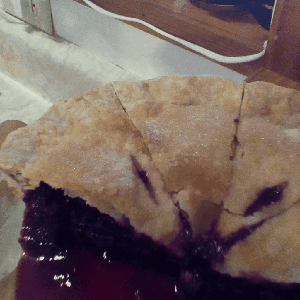Your Grandma has always been right. Lard really does make the best pie crust. After making it a few times now, I can say that I have perfected my recipe, and am now ready to share it. While I did render my own lard, and I store it in the freezer, you certainly don’t need to go to those measures yourself. You can actually buy lard at many grocery stores- or at your local butcher if you still have one of those.
Let me tell you what the lard does in this pie crust, and what some of the other ingredients do as well. I have played with just about every kind of fat trying to get my pie crusts to perfection. Too many crusts have ended up overly crumbly and difficult to work with, or they end up greasy and still difficult to work with. With some kinds of fat I couldn’t get the crust to roll thin enough, so then the pie would be over-baked trying to get the crust to bake through. What the lard does, though, is it makes the dough really nice to work with. It’s almost like working with a really fresh play-doh. You know, when you open up a new can for the first time and it’s had no chance to harden at all? That’s what the lard crust is like. It also happens to be workable right out of the fridge. I have had too many times where I’ve made crust, put it in the fridge, and then it’s way too hard to roll out when I want it.
My recipe starts with 3 cups of all-purpose flour. To this, I add 1 teaspoon of salt and 1 tablespoon of sugar. The sugar is optional. If you are going to use this crust for something savory- like a meat pie or quiche, then leave the sugar out. I mix those things together with a pastry blender, and then add my fats. I use 6 ounces of lard, or 3/4 of a cup. I store my lard in the freezer and take it out about an hour before I want it for crust. When I scoop it out of the jar, it’s usually soft on the outside and firm and hard yet on the inside. Then I also add 4 tablespoons of chilled butter, cut into pieces. I use my pastry blender to cut all the lard and the butter into the flour, when it’s all crumbly and integrated, then I add my liquids.
I learned long ago that adding a dash of vinegar to a pie crust will help keep it tender, adding an egg will also do that, so I add both. Adding them to my pie crust means I can work it a little extra without causing the end product to be tough. So I crack an egg into a bowl and beat it up. To the egg I add 1/3 of a cup of ice water and 1 tablespoon of vinegar. Then I add this slurry to my fattened flour. I use a fork to mix it all together, and once it starts to really come together, I discard the fork and use my hands. I roll it around and knead it a bit until it’s all come together nicely.
Finally, I take this large ball of dough and divide it into four even pieces. You’ve just made enough dough for four 9-inch pie crusts. If you’re using deep dish crusts you’ll want to divide it into three pieces. I pat each piece into a disc, wrap it in plastic wrap, and then put it in the fridge. If I’m not going to use them all within a week, I’ll add the discs to a freezer bag and store them in the freezer. After an hour of resting in the fridge, the dough is ready to be turned into pie.
Simple Pie Dough
makes enough for 4 9-inch pie crusts
3 cups all-purpose flour 1 teaspoon salt 1 tablespoon sugar (omit if using dough for a savory purpose) 3/4 cup lard 4 tablespoons cold butter, cut into small pieces 1/3 cup ice water 1 egg, lightly beaten 1 tablespoon white vinegar
In a mixing bowl, combine the flour, salt and sugar if using. Add the lard and the butter. Use a pastry blender or two knives to cut the fat into the flour. You’ll want to keep cutting until the mixture is even and crumbly.
In a small bowl, combine the ice water, egg and vinegar. Add this slurry to the flour mixture. Use a fork to combine it all into a ball- using your hands toward the end.
Divide dough into four pieces and shape the pieces into discs. Wrap in plastic wrap and place in the fridge for at least an hour- or up to a week. The dough can also be frozen indefinitely if placed in a freezer bag.
To use the dough, remove from the fridge and roll out on a lightly floured surface.
